Kaizen #79 - OAuth2.0 - A Recap and FAQs
Hello everyone!
Welcome to another week of Kaizen!
Today, we will address a few frequently-asked questions about OAuth2.0 that include token generation, scopes, errors etc,.
If you have any other questions, let us know in the comment section. We will offer solutions and add them to this list.
Before we move on to common errors and their solutions, let us look at generating grant, access and refresh tokens for a client.
1. Creating a client
You must register your client on the API console to request access to users' resources. This client must handle authenticating itself to the authorization server and requesting an access token to access the users' resources.
Here is an example for creating a client for a server-based application.
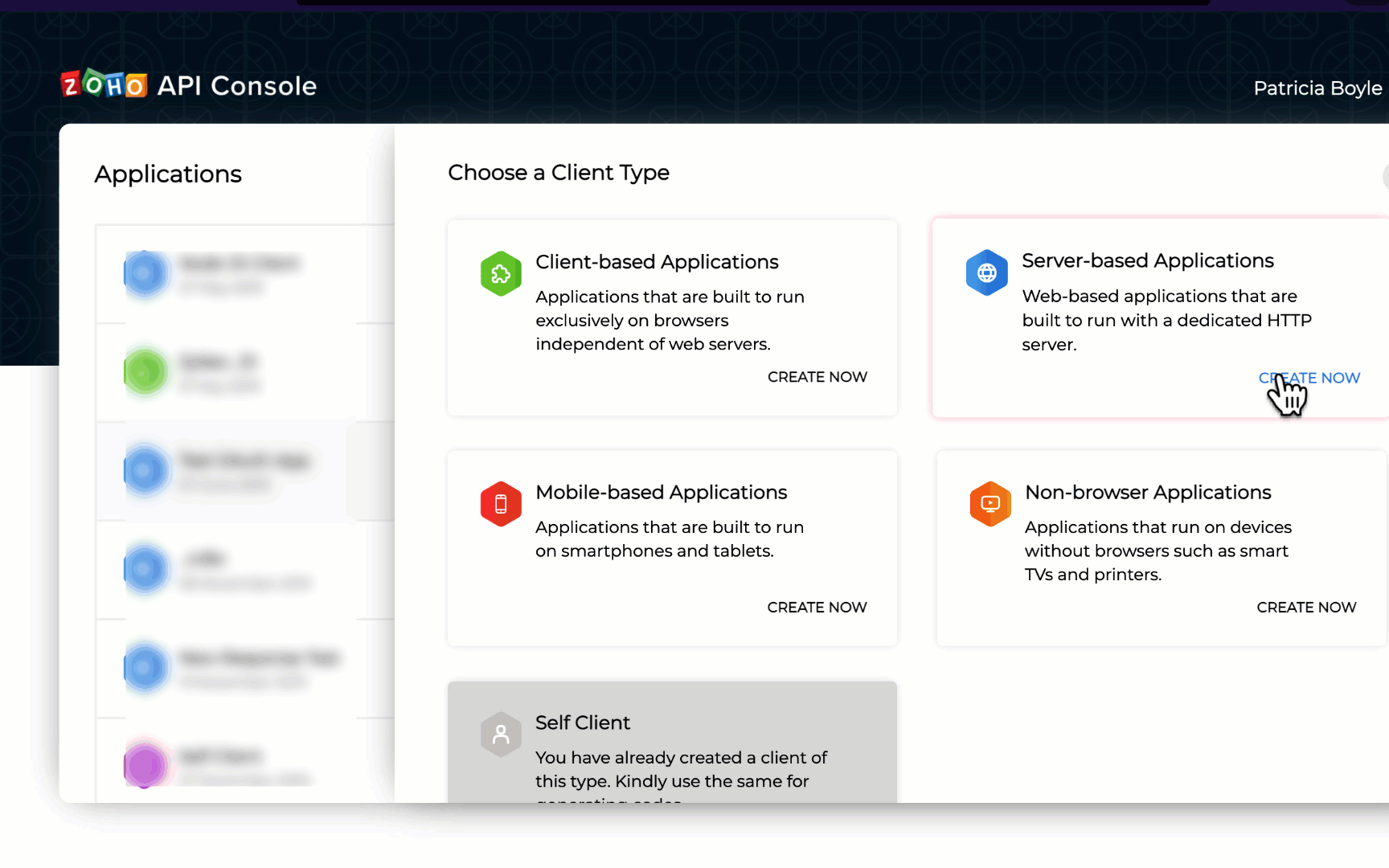
2. Setting up an environment in Postman
- On the sidebar, click Environments > + icon.
- Enter a name for your environment.
- Create the following variables. We will fill in their values as we go along.
->client-id (obtained after registering the client)
->client-secret (obtained after registering the client)
->redirect-uri (given at the time of registering the client)
->accounts-url
->access-token
->refresh-token
->api-domain
->expiry-time - Select Save to save any environment variables you have added.
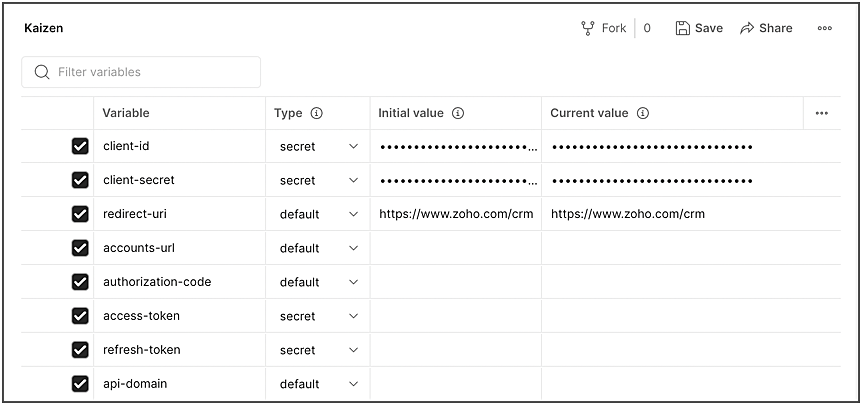
3. Generating the authorization code(grant token)
The authorization code flow is often used when the client is a web application running on a server. This flow uses a server-side redirect URI to receive the authorization code and adds a layer of security, rather than relying on a client-side redirect URI.
What do you need?
- client ID - obtained after registering the client.
- scopes - to get consent from the users to use their data. See the available scopes here.
- response_type - the value "code" as we are requesting for an authorization code.
- access_type - online or offline(to get a refresh token along with an access token, later).
What will you get?
- code - a one-time grant token that you will use to generate access and refresh tokens.
- accounts-server - the Zoho accounts URL that you will use to generate access and refresh tokens. This is the variable accounts-url in Postman.
- location - the API domain from which you must make API calls to access data. This is the variable api-domain in Postman.
Tip:
If you do not have an application, yet, but want to test this flow, copy-paste the following URL in your browser with valid values for the various parameters.
You will receive the grant token as a value to the key "code" in the redirect URL you specified while registering the client.
Here is a GIF of this process.
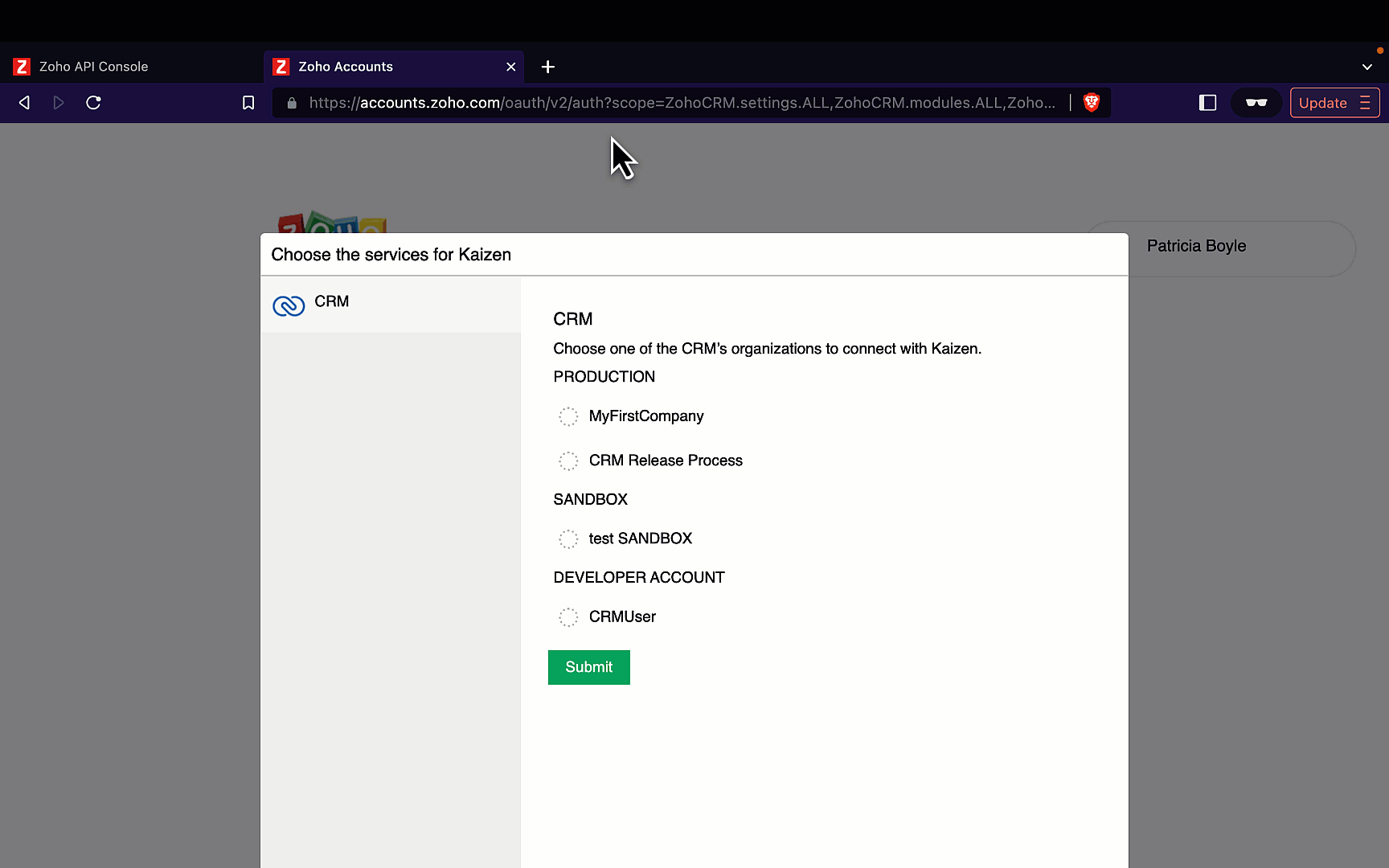
Self-client
Use this option if your application does not have a domain and a redirect URL.
You can also use this when your application is a standalone server-side application performing a back-end job like data sync.
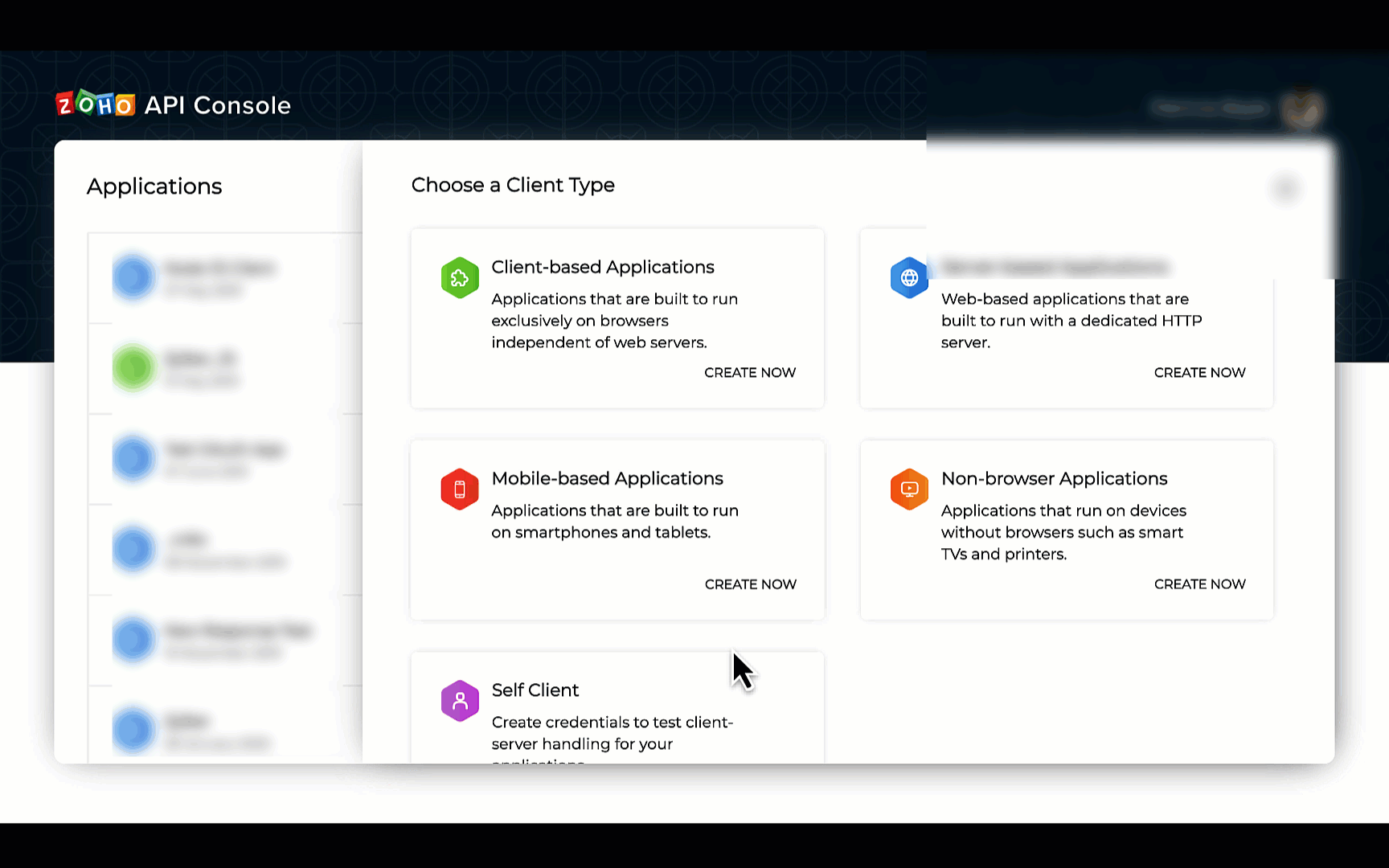
4. Generating access and refresh tokens from the grant token
Access tokens allow the application to access user's data from the resource server. Each access token is valid for an hour, after which, you must use the refresh token to generate a new access token.
Note
Each access token is bound to the scope you specified while generating the grant token, i.e, if the scope while generating the grant token was ZohoCRM.modules.READ, you can only get data from all the modules but not update, create, or delete.
What do you need to generate access and refresh tokens?
- client_id - obtained while registering the client
- client_secret - obtained while registering the client
- redirect_uri - specified while registering the client
- code - the grant token you generated in the previous step
- grant_type - the value authorization_code
What will you get?
- access token - the token to access users' data. Valid for an hour.
- refresh token - the token to generate new access token for the same scope. Does not expire until it is revoked or till the 21st refresh token is created.
- scope - the scope for which these tokens are generated for.
- API domain - the domain to which you must make API calls to access data.
- expiry time in seconds and milliseconds - the time after which the access token expires in seconds and milliseconds. You can use this data to programmatically refresh the access token before it expires for continued access to data.
Here is how it works.
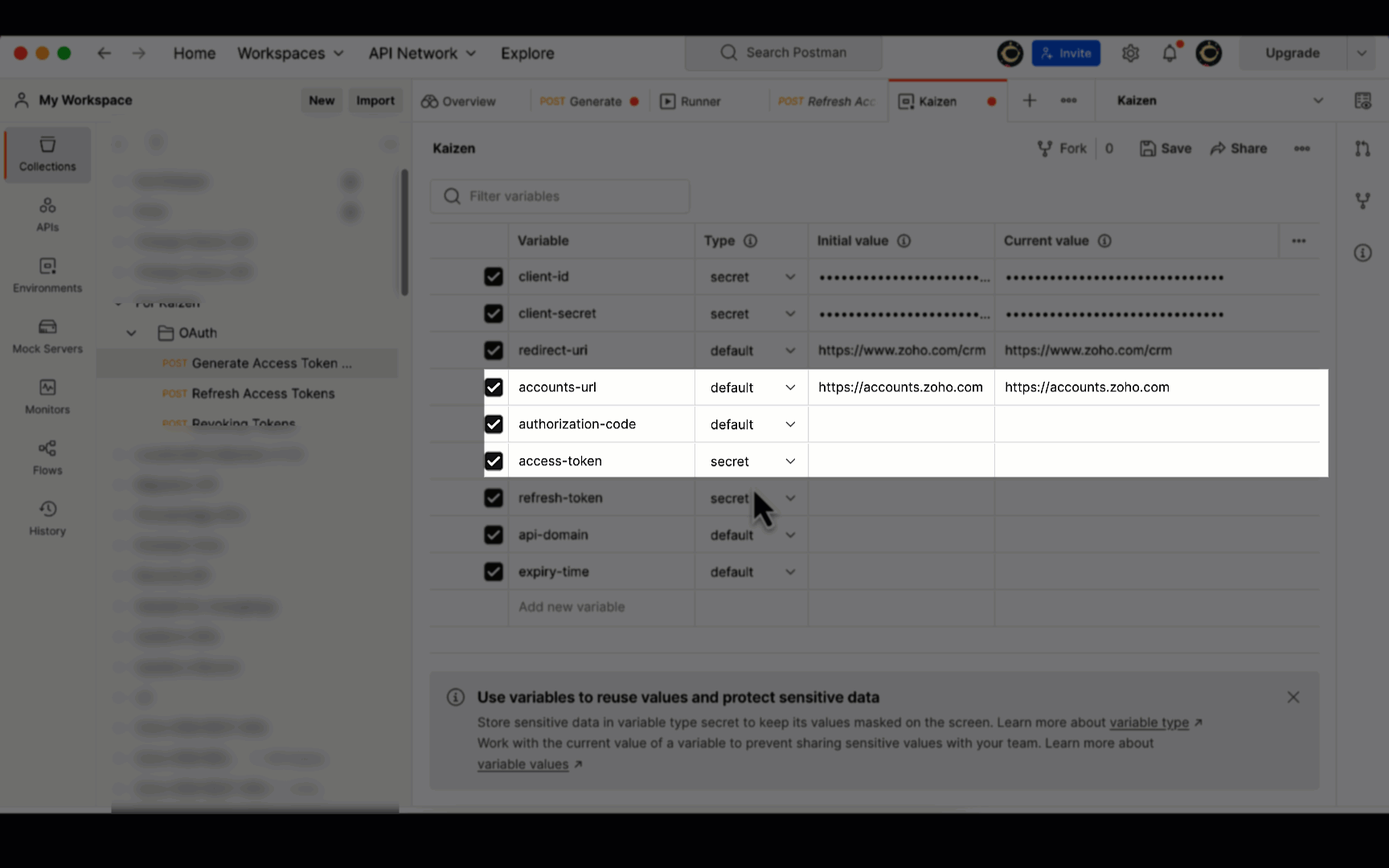
Tip:
When you use our API collection, the request to generate access and refresh tokens comes with a script that automatically updates the values of variables in your environment.
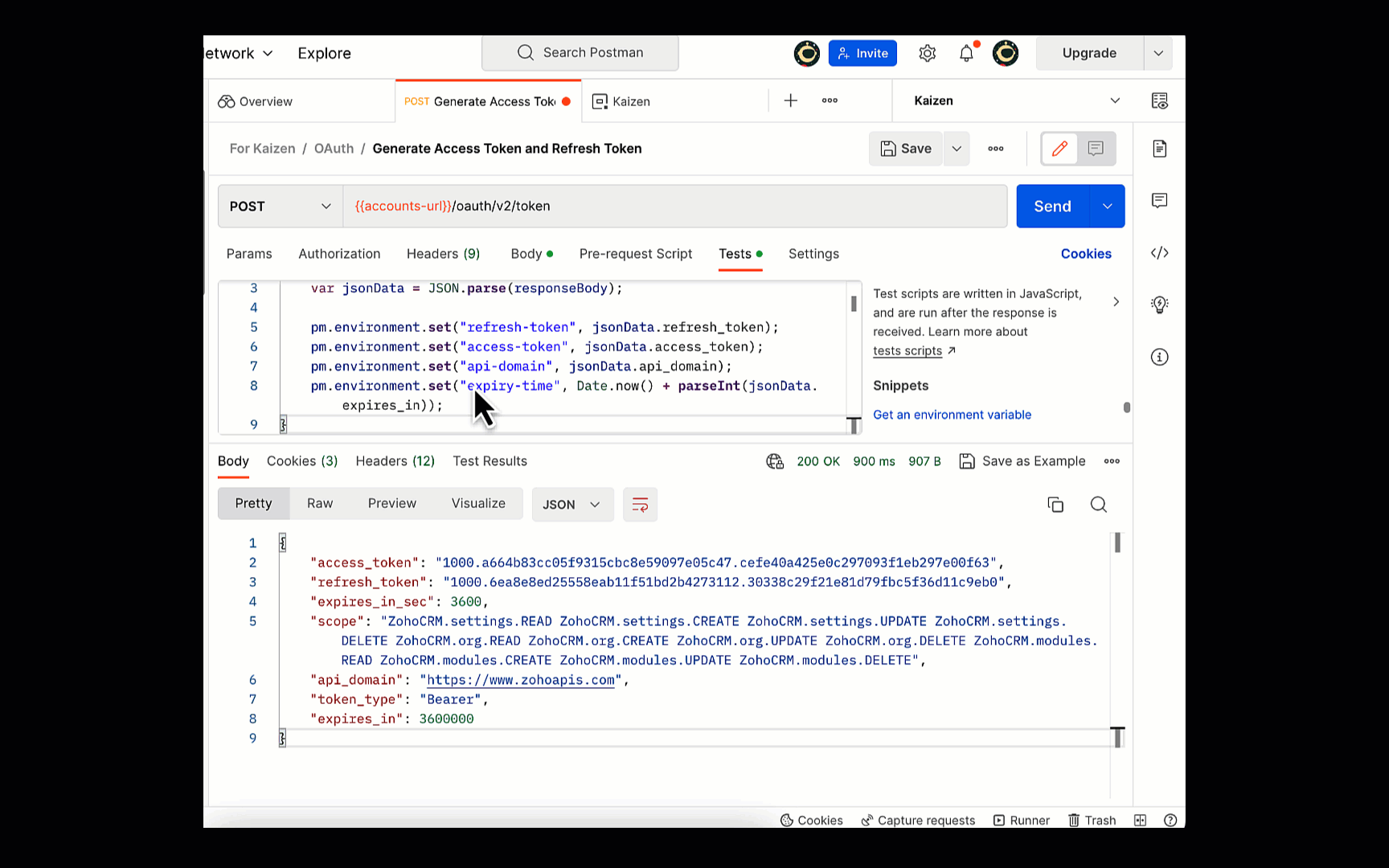
FAQs
1. Validity
- Grant token - Two minutes; one-time use only.
- Access token - One hour.
- Refresh token - does not expire until it is revoked or a 21st refresh token is created.
2. Token Limit
- Grant token - Ten grant tokens in a span of ten minutes.
- Access token - Ten access tokens in a span of ten minutes. When you generate the 11th token, the first-created one will be deleted, automatically.
- Refresh token - Ten refresh tokens in a span of ten minutes. You can have a maximum of 20 refresh tokens. When you create a 21st refresh token, the first-created one will be deleted.
The following are a few common errors you may face while generating tokens.
| Error | Cause | Solution |
invalid_oauth_token | The access token is either invalid or has expired. | Use the right access token or generate a new one from the refresh token. |
invalid_scope | The scope you have used is invalid. | Refer to Scopes for the list of available scopes. |
invalid_code | The authorization code(grant token) is invalid or has expired. | Grant token is valid only for two minutes. Use a grant token to generate access and refresh tokens within this time. Generate a new grant token if you face this error. |
invalid_redirect_uri | The redirect URI you have given in the API console is invalid. | Specify a valid redirect URI to be able to receive a grant token. |
invalid_client | Either the client ID or client secret is invalid. | Specify valid client ID and secret while making authorization calls. The API console has the client ID and secret. |
invalid_response_type | The value of the "response_type" key is invalid. | While generating access and refresh tokens from the grant token, the value of the "response_type" key must always be "code". |
Multi-DC
Zoho CRM is hosted at multiple data centers to comply with the privacy and data protection laws of various countries.
So, if your application is in the US DC but wants to use the data of users in the EU DC, you must enable multi-DC while registering your client.
The various domains and their respective accounts URLs are:
- US: https://accounts.zoho.com
- AU: https://accounts.zoho.com.au
- EU: https://accounts.zoho.eu
- IN: https://accounts.zoho.in
- CN: https://accounts.zoho.com.cn
- JP: https://accounts.zoho.jp
How do you ascertain the domain?
When you generate the grant token, the parameter location gives you the DC that the data is located in.
Similarly, when you generate the access and refresh tokens, the key api_domain gives you the domain-specific API URL.
For example, if you want to get the data of leads from EU, the API URL must be https://www.zohoapis.eu/crm/v4/Leads
We hope you found this post useful. We will meet you next week with another interesting topic.
Let us know your questions in the comment section or write to us at support@zohocrm.com.
Cheers!
Shylaja
New to Zoho Recruit?
Zoho Developer Community
New to Zoho LandingPage?
Zoho LandingPage Resources
New to Bigin?
Topic Participants
Shylaja S
David
Claire
Anu Abraham
Sticky Posts
Kaizen #222 - Client Script Support for Notes Related List
Hello everyone! Welcome to another week of Kaizen. The final Kaizen post of the year 2025 is here! With the new Client Script support for the Notes Related List, you can validate, enrich, and manage notes across modules. In this post, we’ll explore howKaizen #217 - Actions APIs : Tasks
Welcome to another week of Kaizen! In last week's post we discussed Email Notifications APIs which act as the link between your Workflow automations and you. We have discussed how Zylker Cloud Services uses Email Notifications API in their custom dashboard.Kaizen #216 - Actions APIs : Email Notifications
Welcome to another week of Kaizen! For the last three weeks, we have been discussing Zylker's workflows. We successfully updated a dormant workflow, built a new one from the ground up and more. But our work is not finished—these automated processes areKaizen #152 - Client Script Support for the new Canvas Record Forms
Hello everyone! Have you ever wanted to trigger actions on click of a canvas button, icon, or text mandatory forms in Create/Edit and Clone Pages? Have you ever wanted to control how elements behave on the new Canvas Record Forms? This can be achievedKaizen #142: How to Navigate to Another Page in Zoho CRM using Client Script
Hello everyone! Welcome back to another exciting Kaizen post. In this post, let us see how you can you navigate to different Pages using Client Script. In this Kaizen post, Need to Navigate to different Pages Client Script ZDKs related to navigation A.
New to Zoho TeamInbox?
Zoho TeamInbox Resources
Zoho CRM Plus Resources
Zoho Books Resources
Zoho Subscriptions Resources
Zoho Projects Resources
Zoho Sprints Resources
Qntrl Resources
Zoho Creator Resources
Zoho CRM Resources
Zoho Show Resources
Get Started. Write Away!
Writer is a powerful online word processor, designed for collaborative work.
Zoho CRM コンテンツ
-
オンラインヘルプ
-
Webセミナー
-
機能活用動画
-
よくある質問
-
Ebook
-
-
Zoho Campaigns
- Zoho サービスのWebセミナー
その他のサービス コンテンツ
Nederlandse Hulpbronnen
ご検討中の方
Recent Topics
CRM project association via deluge
I have created a workflow in my Zoho CRM for closing a deal. Part of this workflow leverages a deluge script to create a project for our delivery team. Creating the project works great however, after or during the project creation, I would like to associateCustom Fonts in Zoho CRM Template Builder
Hi, I am currently creating a new template for our quotes using the Zoho CRM template builder. However, I noticed that there is no option to add custom fonts to the template builder. It would greatly enhance the flexibility and branding capabilities ifIntroducing the Zoho Projects Learning Space
Every product has its learning curve, and sometimes having a guided path makes the learning experience smoother. With that goal, we introduce a dedicated learning space for Zoho Projects, a platform where you can explore lessons, learn at your own pace,Unknown table or alias 'A1'
I would like to create a subquery but i am getting the following error: Unknown table or alias 'A1' used in select query. This is the sql statement: SELECT A1.active_paying_customers, A1.active_trial_customers, A1.new_paying_signup, date(A1.date_active_customers),All new Address Field in Zoho CRM: maintain structured and accurate address inputs
The address field will be available exclusively for IN DC users. We'll keep you updated on the DC-specific rollout soon. It's currently available for all new sign-ups and for existing Zoho CRM orgs which are in the Professional edition. Latest updateCreate PO from an invoice
We are a hardware and software sales company which receives orders over the internet. We drop ship most of our products from a warehouse outside of our company. Our orders get sync'd into Zoho from our store via onesaas as invoices. It would be greatCollaboration with customers made easy with Zoom Meeting and Zoho Desk integration
Hello everyone! We are happy to announce that you can now integrate your Zoho Desk account with Zoom Meeting. The integration bridges the gap between digital communication and human connection, empowering teams to deliver timely support when it mattersCRM Canvas - Upload Attachments
I am in the process of changing my screens to Canvas. On one screen, I have tabs with related lists, one of which is attachments. There doesn't appear to be a way to upload documents though. Am I missing something really obvious? Does anyone haveTrueSync regularly filling up my local disk
Seems that WorkDrive's TrueSync randomly starts filling up my local hard drive space. None of the folders have been set as "Make Offline" but still it seems to randomly start making file offline. The settings of the app is so minimal and is of no realKaizen #194 : Trigger Client Script via Custom buttons
Hello everyone! Welcome back to another interesting and useful Kaizen post. We know that Client Scripts can be triggered with Canvas buttons and we discussed this with a use case in Kaizen#180. Today, let us discuss how to trigger Client Script when a[Webinar] A recap of Zoho Writer in 2025
Hi Zoho Writer users, We're excited to announce Zoho Writer's webinar for January 2026: A recap of Zoho Writer in 2025. This webinar will provide a recap of the features and enhancements we added in 2025 to enhance your productivity. Choose your preferredPicklist field shows "none" as default
Hello, Is there an option to avoid showing "none" as the default value in a picklist field? I also don't want to see any option displayed. My expectation is to have a blank bar, and then when I display the drop-down list, I can choose whichever I waStage-probability mapping feature in custom module
Hi, I'm building a custom module for manage projects. I would like to implement the stage-probability feature that Potentials has. Is this possible?Create static subforms in Zoho CRM: streamline data entry with pre-defined values
Last modified on (9 July, 2025): This feature was available in early access and is currently being rolled out to customers in phases. Currently available for users in the the AU, CA, and SA DCs. It will be enabled for the remaining DCs in the next coupleField Description is very small
Hello, The field Description in the activity is very small. Why don't try open a new window, or a bigger popup, or increase the width of the "popup". Example:Introducing workflow automation for the Products module
Greetings, I hope all of you are doing well. We're happy to announce a few recent enhancements we've made to Bigin's Products module. The Products module in Bigin now supports Workflows, enabling you to automate routine actions. Along with this update,StatusIQ
Please add StatusIQ to data sources. We using site24x7 and StatusIQ together and site24x7 integration is already there. Thanks and regards, TorstenIn Zoho People, the Operations buttons are frequently not visible or do not appear consistently.
In Zoho People, the Operations buttons are frequently not visible or do not appear consistently. We request you to please investigate and address this issue, as it is affecting daily HR operations and user access.Marketing Tip #14: Increase cart value with product bundles
Bundling products is a great way to increase average order value while giving customers more convenience. Think “camera + tripod + memory card” or “soap + lotion + bath salts.” Bundles make shopping easier and feel like a better deal. It’s a win-win forProblem with Workdrive folders
I'm having a problem a problem accessing files in a Zoho work drive folder when using the Zoho writer app. The problem folder appears grayed out in the Zoho work drive window in both the online and writer application. However I can open the folder inZoho Tables is now live in Australia & New Zealand!
Hey everyone! We’ve got some great news to share — Zoho Tables is now officially available in the Australian Data Center serving users across Australia and New Zealand regions! Yes, it took us a bit longer to get here, but this version of Zoho TablesSortie de Zoho TABLE ??
Bonjour, Depuis bientôt 2 ans l'application zoho table est sortie en dehors de l'UE ? Depuis un an elle est annoncée en Europe Mais en vrai, c'est pour quand exactement ??Add RTL and Hebrew Support for Candidate Portal (and Other Zoho Recruit Portals)
Dear Zoho Recruit Team, I hope you're doing well. We would like to request the ability to set the Candidate Portal to be Right-to-Left (RTL) and in Hebrew, similar to the existing functionality for the Career Site. Currently, when we set the Career SitePrinting to a brother label maker
I see allot of really old unanswered posts asking how to print to a label maker from a zoho creator app. Has their been any progress on providing the capability to create a customized height & width page or print template or whatever to print labels?Auto tracking URL generation based on Carrier
Hi, While creating a shipment order for a package in Zoho Books, I have a requirement that for example, if the carrier is Delhivery and tracking number is 1234, then can automatically the tracking link/URL be generated as www.delhivery.com/1234. Similary,Helper Functions and DRY principle
Hello everyone, I believe Deluge should be able to use 'Helper functions' inside the main function. I know I can create different standalones, but this is not helpful and confusing. I don't want 10000 different standalones, and I dont want to have toZoho CRM Portal Field Level Permission Issue
Hi Support Team, I am using the Zoho CRM Portal and configuring field-level editing permissions. However, we are unable to restrict portal users from editing certain fields. We have created a portal and provided View and Edit (Shared Only) access forHolidays - Cannot Enter Two Holidays on Same Day
I have a fairly common setup, where part-time employees receive 1/2 day's pay on a holiday and full-time employees receive a full day's pay. Historically, I've been able to accommodate this by entering two separate holidays, one that covers full-timePre-orders at Zoho Commerce
We plan to have regular producs that are avaliable for purchase now and we plan to have products that will be avaliable in 2-4 weeks. How we can take the pre-orders for these products? We need to take the money for the product now, but the delivery willCustomer ticket creation via Microsoft Teams
Hi all, I'm looking to see if someone could point me in the right direction. I'd love to make it so my customers/ end users can make tickets, see responses and respond within microsoft teams. As Admin and an Agent i've installed the zoho assist app withinZoho Books' 2025 Wrapped
Before we turn the page to a new year, it’s time to revisit the updates that made financial management simpler and more intuitive. This annual roundup brings together the most impactful features and enhancements we delivered in 2025, offering a clearAdd specific field value to URL
Hi Everyone. I have the following code which is set to run from a subform when the user selects a value from a lookup field "Plant_Key" the URL opens a report but i want the report to be filtered on the matching field/value. so in the report there isCan multiple agents be assigned to one ticket on purpose?
Is it possible to assign one ticket to two or more agents at a time? I would like the option to have multiple people working on one ticket so that the same ticket is viewable for those agents on their list of pending tickets. Is something like this currentlyRestrict Users access to login into CRM?
I’m wanting my employees to be able to utilize the Zoho CRM Lookup field within Zoho Forms. For them to use lookup field in Zoho Forms it is my understanding that they need to be licensed for Forms and the CRM. However, I don’t want them to be able toZoho removed ability to see all Scheduled Reports!
If you are not the owner of a scheduled report, Zoho recently removed the capability to see each scheduled report. As an admin who relies on seeing all scheduled reports being sent, this is a terrible update. Now I cannot see ANY scheduled reports...even the ones I am being sent!! This should be a setting for admins to control. This is a bad update.Admins cannot see each others' Scheduled Reports?!
Very frustrating that as an admin I cannot see what my reports my fellow admins have created and scheduled. After asking about this on the help chat, I was told the issue is trust and security. By giving someone Admin status, it means we trust them with those responsibilities. Please change this, it is not a good process to have to bother other users to change a report or change users within a report.Add multiple users to a task
When I´m assigning a task it is almost always related to more than one person. Practical situation: When a client request some improvement the related department opens the task with the situation and people related to it as the client itself, the salesmanThis user is not allowed to add in Zoho. Please contact support-as@zohocorp.com for further details
Hi Team, when I,m trying to create a email account (imagixmidia.com.br) it's showing this error >> This user is not allowed to add in Zoho. Please contact support-as@zohocorp.com for further details plz help me thanksEdit default "We are here to help you" text in chat SalesIQ widget
Does anyone know how this text can be edited? I can't find it anywhere in settings. Thanks!Feature Request: Sync Leave Tracker to Zoho Mail / Calendar or provide option to download information
Zoho Leave Tracker offers the option to sync the leave Calendar to Microsoft 365 and Google Calendar. Adding an option to sync to Zoho-Mail Calendar would avoid duplication and add significant value for users. An alternative would be to allow users toNext Page












